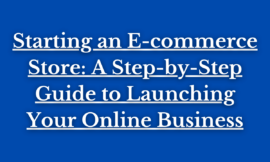Dropshipping 101: Building a Profitable Online Store without Inventory
Introduction
Starting an online business is an exciting prospect, but the idea of managing inventory and dealing with product logistics can be daunting. Fortunately, there is an alternative: dropshipping. Dropshipping allows entrepreneurs to start an online store without having to acquire physical inventory. This article will provide a comprehensive guide to building a profitable online store using dropshipping.
Dropshipping is a retail fulfillment method that allows store owners to source products directly from a supplier or third-party vendor and have them shipped directly to their customers. This eliminates the need for store owners to handle the inventory and streamlines the supply chain by removing the middleman. The result is an efficient and cost-effective way to start an online business.
Setting Up Your Dropshipping Store
Setting up a successful dropshipping store is the key to making a profit. The first step is to choose the right ecommerce platform. This platform should be user-friendly, offer payment options, and provide reliable shipping services. Once you have chosen an ecommerce platform, you need to find a reliable product source. This source should have a wide selection of products that you can offer in your store. Finally, you need to curate the right product mix for your store. Consider what products are most popular in your niche and what products you can offer competitively. With the right product mix, you can maximize your profits and ensure a successful dropshipping experience.
Crafting a Winning Strategy
When it comes to running a dropshipping store, having a winning strategy is essential. To achieve success, you’ll need to create an effective marketing plan, leverage SEO for greater visibility, and exploit the power of social media.
Creating an effective marketing plan involves identifying your target audience and creating content that resonates with them, as well as developing a comprehensive strategy for advertising and promotion. SEO is highly important for dropshipping stores, as it can help you improve your online presence and reach new customers. Finally, using social media is a great way to build relationships with customers, share updates, and increase brand awareness.
Developing Your Brand
When it comes to building a successful dropshipping store, developing your brand is key. To make your store stand out, you must prioritize the look and feel of your website, the content you display, and the customer service you provide. To build trust with your customers, ensure that your products are of high quality and backed by a reputable supplier. You should also have a customer service system in place that allows for quick and effective responses.
By optimizing the branding of your store, you can make it stand out from the competition and create a better customer experience. Providing exceptional customer service is also essential in establishing trust and loyalty with your customers. By leveraging the power of social media, you can create meaningful relationships with your customers and reach a larger audience. Finally, by investing in quality product photography, you can showcase your products in the best light and make them more attractive to potential buyers.
Optimizing Your Operations
When it comes to running a successful dropshipping store, it’s important to optimize your operations. This means streamlining processes, automating repetitive tasks, and leveraging analytics to inform decisions. Improving your store’s efficiency is key to ensuring maximum profits.
When it comes to automating tasks, there are a range of tools available to help you streamline your operations. You can automate product updates, customer notifications, and inventory tracking. Additionally, utilizing data analytics can help you better understand customer behavior and optimize for greater success. With data-driven decisions, you can target the right customers, improve product curation, and make smarter business decisions.
Finally, when it comes to managing inventory, it’s important to know when and how to restock. Having the right item in stock is essential, so it’s important to be aware of when there is a shortage and how much you need to replenish. It’s also important to be aware of the risks associated with working with suppliers, as well as when to discontinue a product. By understanding these elements of inventory management, you can gain greater control over your store and optimize your profits.
Managing Your Inventory
Managing your inventory is an important part of running a successful dropshipping business. It’s essential to restock your store regularly to ensure you’re offering your customers the latest products. When considering when and how to restock, it’s important to think about your suppliers – do they have an extensive inventory and offer timely shipments? Knowing how to deal with different suppliers is key to managing your inventory. Additionally, you should be aware of when it’s time to discontinue a product if it’s not selling. Monitoring your store’s performance and staying up to date with trends will make it easier to make informed decisions about which products to stock and which ones to discontinue.
Conclusion
Dropshipping is a great way to start an online store without the need to manage inventory. With the right ecommerce platform, product source, and marketing plan, you can create a profitable online store that will stand out from the competition. Key points to remember include utilizing SEO for visibility, building trust with customers, automating repetitive tasks, and knowing when to restock or discontinue a product. With these tips in mind, you can start your dropshipping journey with confidence.




